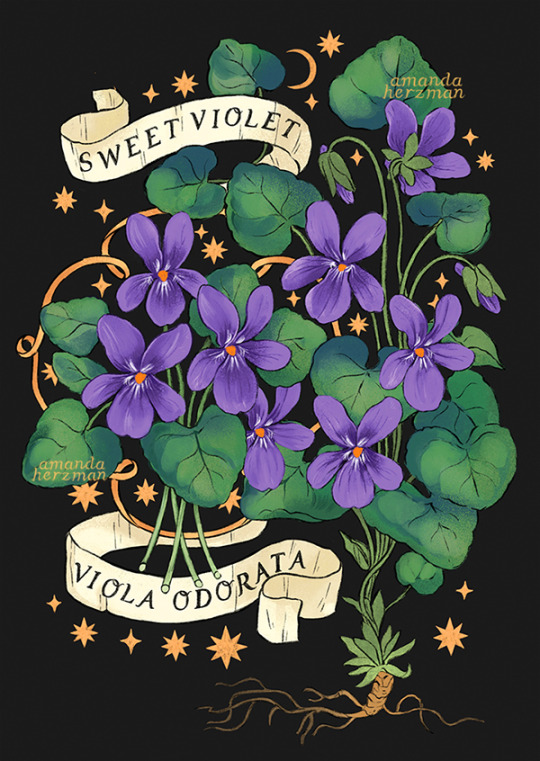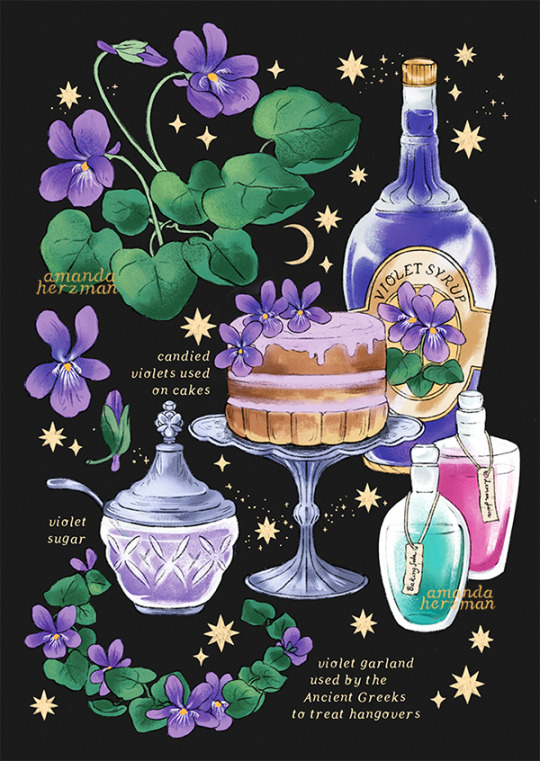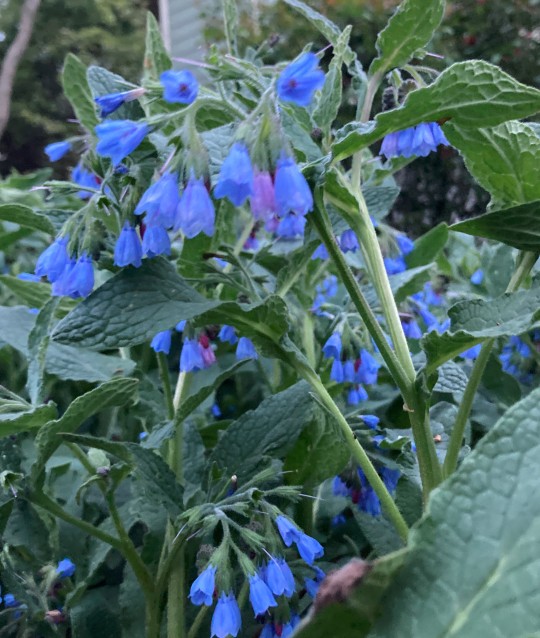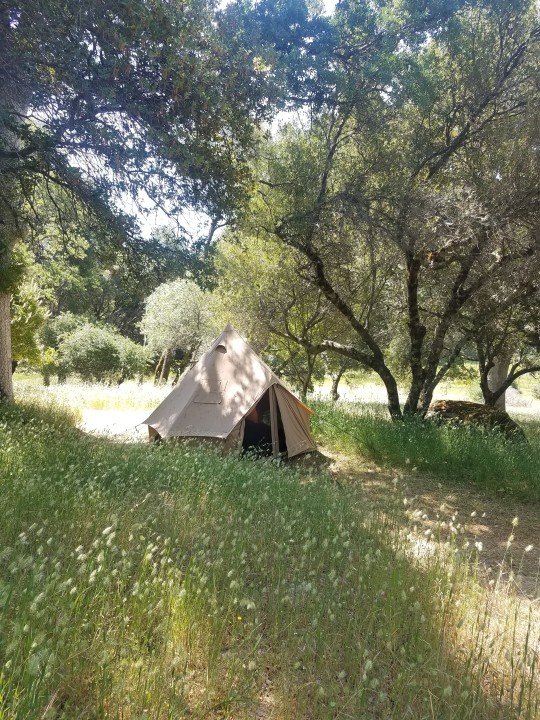#plant lore
Photo


Sweet violets for February! Violets are edible and were a popular flavor in the late 1800s. Today they've gone out of fashion, and instead flavors like vanilla fill up our flavor palate. Violet pastilles were first made by the Monks of Benedictine, in France. Today a 9th century recipe is still used to create these pastilles.
#botanical art#plant lore#flowers#violets#this is just a snippet of the herbolgist folklore!#but omg ive never actually tried violet candy and now i really wanna#artists on tumblr
1K notes
·
View notes
Text
Plant Lore in Episode 8


Even though they're genetically similar, Knives doesn't need to eat at all, whereas Vash is always hungry.


Plants are usually cloned, but they're also able to give birth to new Plants. (Are these birthed Plants always Independents?)

Vash's genetic makeup is very human. (Unclear if this also applies to Knives.)


Different Plants can generate different things: gravity, electric, chemical compounds, amino acids, among other things...
...presumably the Plants in Stampede can also produce water, UV rays, oxygen, and organic systems like in the manga

#trigun#trigun stampede#trigun stampede episode 8#tristamp spoilers#trigun stampede spoilers#plant lore#trigun volume 1
124 notes
·
View notes
Text
Just published a gen podfic about Vash and his sisters. It's actually a pulled chapter from the Reporter's Notes series, but I felt it could stand on its own as a gen oneshot.
Vash: Ryan Tibbitts
Meryl & plant sisters: @aubielikey

#trigun#trigun stampede#vash the stampede#plant sisters#plant lore#trigun gen fic#trigun fanfic#trigun podfic
12 notes
·
View notes
Text
"The intimate associations between the worlds of witches, witchcraft and plants can be likened to an ancient fabric draped upon bony shoulders. Like a verdant shroud, the clandestine power between witch and plant serves as a well-worn cloak connecting dreaming and waking. In both their revealed and concealed powers, plants have long held secrets which manifest at the interface between human and spirit power. The plants carry the stories if only one will take the time to to listen."
—
The Witch's Cabinet:
Plant Lore, Sorcery and Folk Traditions
1: 'Plants and Witch's; A Folkloric Apothecary'
by Corrinne Boyer
119 notes
·
View notes
Text
The podcast is here! :D
Join our discussion of plant lore, with a healthy dose of tangents XD It's a joy to be able to discuss and dissect this story with my frens <3
#trigun#trigun maximum#trigun stampede#tripod maximum#podcast#plant lore#tombiwidgeon scribbles#Spotify
10 notes
·
View notes
Text

Extended write-up of my personals for those intrigued:
Cute little 30 yr girl. 4' 10", 130 lbs, green eyes, straight teeth, bangs, glasses, big tits, with curly blonde hair. dresses gothic pastel Japanese, listens to lil peep. model. studied fine arts. photography. dance. studied music. studied digital photography and black and white film photography. creative writing (fiction and non fiction). gymnastics. theater. cooking. sewing. esthetician research. certifications in adobe Photoshop, dream Weaver, and illustrator. dog training classes. Horseback riding trained English and western. Worked at the zoo!. Experienced in handling all animals.
I like to surf I can do archery I can kayak I can canoe I can white water raft I can drive a boat. I can do pottery on the spinning wheel. I can blow glass. Contortionist levels of flexibility. Great core strength from being in sports my teenage hood. I can competitively swim, I've at least taken swim lessons a million times so I know all of the training.
I'm one of those little dorky smarty pants know it all girlies. Nowadays my aesthetic is sundresses and bodysuits and the like (especially the two combined) crop tops, high rise shirts and skirts. Shawls. Different fabulous flower clad Cat ear adorned headband in my hair. Very chic . Japanese, blackpink, pastel, sakura, mother earth type of look. I played the clarinet. I drew and painted. I write fiction and nonfiction and poetry. I do photography digital and black and white film photography and I know how to develop it in the dark room, and gymnastics. And I love cooking. And I took psychology college courses in high school because I have a passion in that too. I can sew. And I have a green thumb I was just gardening outside taking care of my plantains. I'm about to start growing weed. And mushrooms. I can edit videos very well and I'm extremely tech savvy and I studied music, and I'm trained in the marching band so I'm trained in keeping rhythm and beat. 😁🤙🏻 hydroponic indoor plant gardening too!.
Lesser albeit mentionable knowledge of maths, I studied trigonometry in school. I have a basic yet reputable knowledge of chemistry, as I studied that as well as an honor student, as well as basic human biology, and marine biology (being the lesser of my expertise.) And I am trained in research in general as well.
I've been to 13 states, 8 countries
https://linktr.ee/dollymaye
#bookworm#nutrition#about myself#plantlover#plant lady#plant lore#poetry#lil peep#music#sadgirl#sad boi shit#goth chick#goblincore#gaming#graphic design#graphic art#fae folk#goblin culture#mushroomcore#whimsicore#whimsigoth#japanese art#sakura#cherry blossom#big tiddy committee#big tiddy gf#big tiddy goth gf#nerdy girls#blondie#curly hair
8 notes
·
View notes
Note
Loved your tree story. Can children really develop extra senses when their home is troubled? As a toddler I predicted my brothers birth, i knew my mom was pregnant about a week before she did. One time in college I did mushrooms and walked past some trees in an apartment complex, I swore they said hello to me and laughed a bit at the state I was in. I have this book called.... "the secret language of plants". I never got too deep into it (easily distracted) but the whole thing is kind of about talking to plants and how they can communicate with us, and tell us their potential medicinal uses, and things like that. Have you heard of it? If you ever read it I would love to know your thoughts ❤️
Yeah I do believe that kids can develop extra senses when they're in a troubled environment very young! What you're describing is another layer of extra senses, I've never been able to predict anything like that, that's very cool. I've never managed to ask a plant about medicine uses, but I knew instinctively that yarrow is medicinal as a kid, I just didn't know what for (but I collected it anyway).
Thank you for sharing your story!
4 notes
·
View notes
Text
Just a disclaimer:
When I reblog lists of herbal uses, it’s for my own personal use, so I can cultivate a general understanding on what a herb does in different witches’ perspectives.
I do not support lists of herbs that just state the herb and a single word “use” I think it does no justice to the plant.
Everything in nature has virtues, sometimes those virtues can only be accessed by using the plant a certain way.
And sometimes the specific plant you are harvesting from will have a completely different set of uses than what it’s typically known for.
Unfortunately witchcraft is seldom easy to categorize and make accessible for the masses and posts that make lists like these should always be read with utmost discernment.
#folk witchcraft#traditional witchcraft#witchcraft#occult#witchblr#trad witch#witch#folklore#witch history#trad witchcraft#plant lore#plant witchcraft#herbology#occult herbalism
36 notes
·
View notes
Text

Virginia bluebells (Mertensia virginica). Traditionally, you have to be careful with bluebells because they are the fairies' flowers. Some people consider them unlucky to pick or bring inside the house.
8 notes
·
View notes
Note
Is there a story behind your url/user name?
Ahh back when I was younger I made a joke with myself that "hey, all I really do is lay in one place and drink water occasionally, I'm probably a plant at this point" and thus made that my entire identity.
Then when making my tumblr blog, probably-a-plant was already taken so I just added "thing" to the end.
5 notes
·
View notes
Text



:: summer days & witchy reads ::
((Celtic Tree Magic by the Witches' Almanac))
2 notes
·
View notes
Photo

The vanilla orchid (Vanilla planifolia). Specifically, my vanilla BEAST.
Note, I do say beast intentionally. Orchids as a whole remind me of animals more than other plants. I’m not the only one it appears...
Luigi Berliocchi gives some grating laudatory passages about orchid hunters of the colonial 19th century in his book The Orchid in Lore and Legend. But he also talks about people like Hieronymus Tragus (1498-1554). Despite the awesome name, Tragus is NOT the Hieronymus Bosch Garden of Earthly Delights fame. While the latter was painting people humping giant strawberries, Tragus was only just germinating. Tragus went on to make a scientifically fanciful yet aesthetically appealing observation: orchid flowers look incredibly similar to animals. People have gone on to speculate an evolutionary mechanism for this (e.g., flowers that resemble pollinators are more likely to attract them and successfully reproduce the plant). (pp. 35-36)
But long before Darwin set sail on the Beagle, Athanasius Kircher (1610-1680) speculated that orchids sprouted from animal sperm that dripped out onto the ground because --- get this --- animals liked to copulate in fields where orchids grew plentiful (pp. 36-37). We can’t blame Kircher for overlooking the fact that making love in a field of flowers is particularly romantic and inspirational; he was a Jesuit. Clerical celibacy has been enforced in the Catholic Church since the 11th or 12th century.
Berliocchi expounds upon the uses and applications of vanilla elsewhere in his book. Guess what? One of the reported uses was as an aphrodisiac (pp. 110-111). The Aztec emperor Montezuma II (c.1466-1520) was reported to have used this liberally (p. 111). It must have worked because the emperor had 19 children according to Fernando Alvarado Tezozomoc, possibly a descendant of Montezuma himself and a renowned chronicler of mestizo history and language.
8 notes
·
View notes
Photo

Plants That Will Get You Pixie-Led
There’s an age-old belief in that the Good Folk, The Fair Folk— or whatever name they wish to be called, lest you offend them— possessed heightened powers during Halloween. In contemporary America, where I celebrate Halloween each and every year, this isn’t a widely held belief (as much as I wish it was). The veil is thinner on Halloween, and the things which normally remain out of view are free to move about and stretch their legs. My first introduction to the concept of “Halloween is for the Fae” was actually in poetry, with poems like Halloween by the eponymous Scottish poet Robert Burns, or my personal favorite, Halowe’en by American writer and poet Joel Benton. (I know these two poems have the same name and it makes for an awkward sentence, there’s literally nothing I can do about it.)
I have drawn fae-inspired Halloween art before, but this time I wanted to draw a little something where I could also include a few interesting folklore tidbits. This article and accompanying artwork was inspired by an actual misremembered fact I had wrongly attributed to the Elder Tree— I incorrectly thought that it was on Halloween that standing beneath an Elder tree caught you a glimpse of the Fairy King, when it is in fact, Midsummer’s Eve that this spectacle occurs. By the time I realized this, I had already finished the artwork and began writing this article that you’re now reading. What most likely happened was that I confused this bit of lore for the folk ballad Tam Lin, in which a young woman named Janet helps a former mortal escape the clutches of the Faery Queen. Janet helps Tam Lin narrowly escape being used as a sacrifice as part of the Faery Queen’s “Tithe To Hell”, which she must pay on Halloween. That is a VERY loose summary of the ballad which is at least as old as the 16th century, but you get the idea— Faeries and Halloween were once synonymous with one another.
It shouldn’t be a surprise at this point that I’m a big fan of this Halloween-Fae tradition, and I say we bring it back. For my part, I have included this handy illustrated and written guide on how to contact the Fair Folk and get yourself Pixie-Led, away from the hustle and bustle of dreary city life and into the ancient and alluring woods that exist beyond the veil. Enjoy reading this article while you can, because if you do decide to seek out a fairy ring or field of sitchworts, you may probably never get the chance to read this again… not sure if they have the internet in Fairyland.
Fairy Ring Mushroom (Marasmius oreades)
The Fairy Ring Mushroom is probably the most well-known of all of the flowers, trees and fungi that I’m going to discuss here. In folklore, it was said that fairy rings appeared where the Fair Folk held their moonlit dances, and that any human foolish enough to enter the circle would be punished by the Good Folk and/or spirited away to their realm. The ring of dried grass that often accompanied the ring of mushrooms was known as Elf Grass, and was said to be worn down by the Faerie’s vigorous dancing. Of course, all this has a scientific explanation— the mushrooms growing in a perfect circle, the fungi depleting the nutrient in the soil creating the dried-up grass…but of course, none of those explanations are any fun.
Elder (Sambucus)
Elder is a plant that is steeped in folklore and legend— it’s a favorite of mine to discuss and I have previously written about it in my article on Cursed Plants and Witch Trees. However, while elder is mostly associated with witches and witchcraft, it is also associated with faeries and elves. In Denmark, it was believed that standing under an elder tree on Midsummer Eve after midnight granted the viewer a glimpse of the King of Fairyland as he rode with his royal retinue in the dusky summer twilight. Not quite paying a Tithe to Hell on Halloween as the Faerie Queen did in Tam Lin, but still quite the sight to see!
Foxglove (Digitalis)
One the oldest names of the foxglove is the folksglove, a reference to the Fair Folk, as it was said that this plant was used by Faeries as gloves, hats, and other clothing items. Along with the cowslip, also known as the “fairy’s cup”, the foxglove was said to be a favorite of the Fairies’ many floral accouterments, as it grows deep within wooded hollows, a place where fairies are said to dwell. But this fun little detail about Faery gloves could also be viewed as a cautionary tale, as digitalis is a potent poison and not something to be picked on a whim. Just like you don’t mess with Faeries, you don’t mess with poisonous plants such as this.
Stitchwort (Rabelera holostea)
Up until recent years, the Stitchwort was placed in the genus Stellaria (the same genus Chickweeds and other flowers are placed in). In 2019 it was re-assessed and re-categorized into the genus Rabelera ( and— here’s your useless fact of the day.) In Somerset, England, Stichworts are simply called “Pixies” as anyone who picks one is likely to be pixie-led. They weren’t mincing words, were they?
St. John’s Wort (Hypericum perforatum)
A powerful plant in many folk remedies, St. John’s Wort is still used in all manner of ways in the modern era. Like the elder tree, St. John’s Wort is a plant that has a storied reputation in folklore, but I will leave you with this one tidbit that pertains to the topic at hand— being pixie-led by the Fae. In the Isle of Man, it was said that any person who had the misfortune of stepping on St. John’s Wort after sunset would be carried away by a Faery horse. That equinus fae would rise beneath the unfortunate trespasser and spirit them away, galloping until dawn and finally dropping them miles away from home; try to explain that to your friends and family.
Bibliography and Works Cited
Baker, Margaret. Discovering the Folklore of Plants (Shire Discovering). 3rd ed., Shire Publications, 1996.
Folkard, Richard. Plant Lore, Legends, and Lyrics (Illustrated). Independently published, 2020.
Gilman, Clarabel. “Bits of Plant-Lore.— (I).” The Journal of Education, Vol. 49, No. 9, March 1899, pp. 226-227, https://www.jstor.org/stable/44045817.
Grieve, Margaret. A Modern Herbal: The Complete Edition. Illustrated, Stone Basin Books, 2015.
Mushroom. “Magical Fairy Rings: The Science and Folklore.” Mushroom Appreciation, 21 Aug. 2022, www.mushroom-appreciation.com/fairy-rings.html.
Sharples , Matthew T. “Rabelera Holostea.” Rabelera Holostea | International Plant Names Index, International Plant Names Index, 14 Nov. 2019, https://ipni.org/n/77205026-1.
9 notes
·
View notes
Text
The Lovers Oasis
In the dry caves of Balash lives a small sink like basin. At unpredictable times the sink will fill and subsequently drain with water. When the pond fills, seeds germinate and leaves spread creating a thicket of youth among void. Though that youth quickly dissolves as the water levels decrease and the basin reveals it's dry crackly rock.
Only two plants remain during the dry days and months. Those two are the lovers, and when the oasis crumbles they still endure because of their unique relationship.
As the water disappears down a set of holes littering the bottom of the uneven bowl, a group of white tendrils dance down from the cork textured bark of the Gumag Tree. The tendrils of the Nazar Vine leave their home in the tree top and follow the stream of water below the drain. The root of the vines tap directly into the tree's xylem and feed it water from the now distant source. As the water levels increase once more and the oasis flushes out, the vine retreats back into the tree top it calls home.
In exchange for the extra mobility, the Nazar Vine loses out on any sort of leaves. The darkness of the cave and the tree canopy led to the loss of chlorophyll in it's veins long ago. For sustinence a different root of the vine, taps into the phloem of the Gumag Tree and enjoys it's meal.
Once a year, young Orcs of Cerano make a journey to the Lovers Oasis on the first year of their marriage. On this intimate trip they participate in a handful of magical ceremonies to foster a long lasting relationship. Like Gumag and Nazar, they will use their personal strengths to work together in environments that make it hard for those alone to survive.
Art coming soon!
Bonus fun fact: Gumag and Nazar are popular book characters from the well known Orcish novel, A Twisted Tale.
#dungeons and dragons#fantasy#tales of cerano#worldbuilding#writing#orcs#orc culture#lore#plant lore#mutualism
2 notes
·
View notes
Text

If you're seeing this Large Camas on your feed, let this be your reminder to engage in your playful side, to experiment with what makes you happy and safe ways you can allow your inner child out and find wonder in the small things.
2 notes
·
View notes
Text
Plum Folklore and Magical Uses
In autumn of last year, my Handsome Assistant and I planted a plum tree. As we work on getting rid of the lawn in the backyard chunk by chunk, we’re replacing those chunks with tree guilds. We couldn’t decide what kind of fruit tree we wanted for that space — it had to be a dwarf variety, and it needed good disease resistance. If the fruit didn’t need a lot of processing to be edible, so much the…

View On WordPress
0 notes